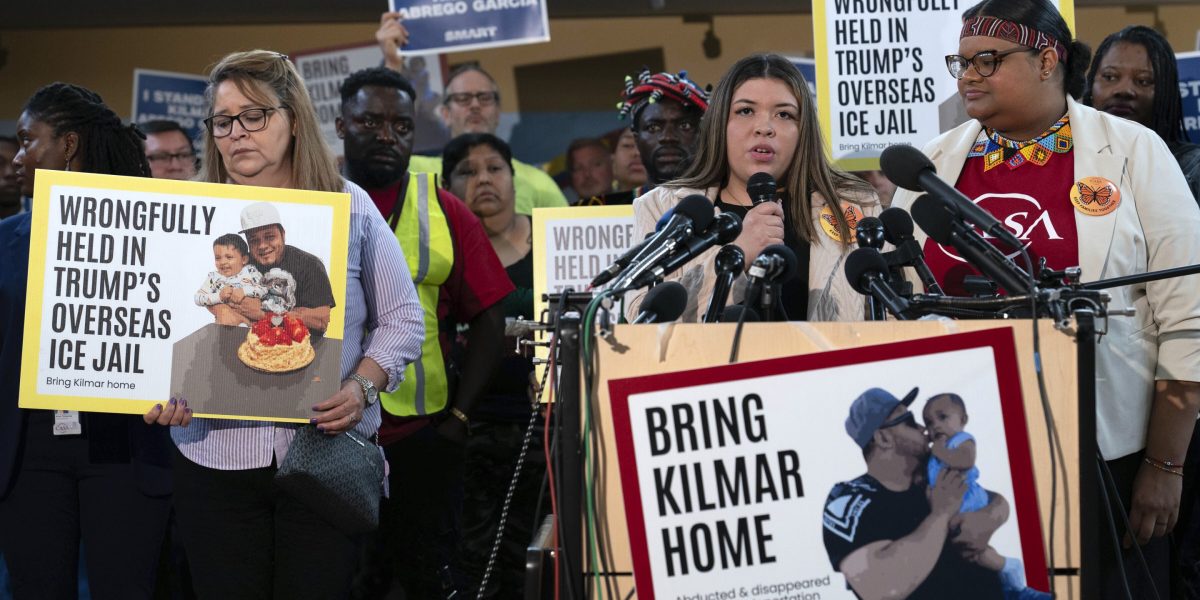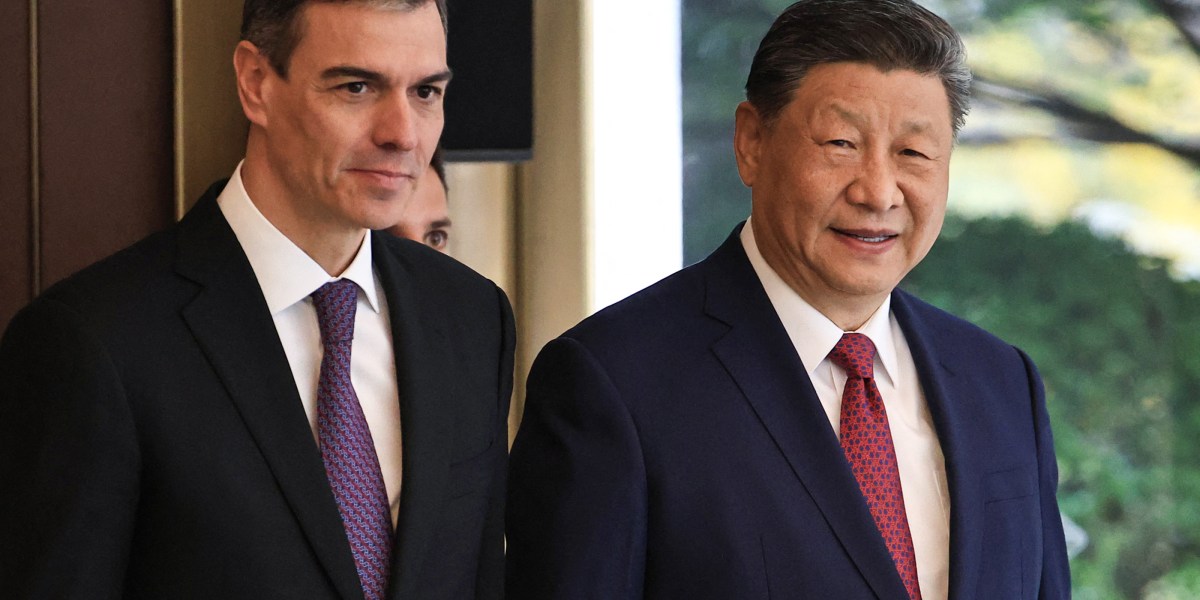Trade between the world’s two largest economies—a link that defined the world economy for two decades—is on life support. U.S. tariffs on China now stand at 145%; China’s tariffs on the U.S. now stand at 125%. And that’s just the baseline, not including additional tariffs on specific goods like steel (in the case of the U.S.) or agricultural products (in the case of China).
“The tariff rates are now so high as to be prohibitive of most direct bilateral trade,” says Yeling Tan, a professor of public policy at Oxford University.
Even Beijing recognizes that, with tariffs this high, U.S. goods don’t have a chance. “Given that American goods are no longer marketable in China under the current tariff rates, if the U.S. further raises tariffs on Chinese exports, China will disregard such measures,” the country’s finance ministry said in a statement announcing its new 125% tariffs.
The tariffs are rapidly unwinding a close economic relationship: Chinese manufacturers built products, from lawn chairs and Christmas ornaments all the way to smartphones and semiconductors, and U.S. consumers and businesses bought them.
Both Washington and Beijing have signaled they’re open to negotiations, even if there are no public signs that they’re talking. Each thinks the other need to move first; on Friday morning, CNN reported that the U.S., rather than requesting a phone call with Xi, demanded China should instead request a phone call with Trump.
The U.S. may have realized its steep tariffs on China are unsustainable. Late Friday, the White House exempted electronic goods like smartphones, laptops and computer processors from U.S. tariffs, including some imposed on China.
Tariffs and trade
The U.S. imported $438 billion worth of goods from China in 2024, compared to $143.5 billion worth of China-bound exports, according to data from the U.S. Census Bureau.
Trump’s 145% tariff on Chinese imports is just the baseline. There’s also 25% tariffs on steel and aluminum imports, and the looming threat of a 25% tariff on any country that uses Venezuelan oil, a set that includes China. And then there’s all the earlier tariffs slapped by previous administrations: on Chinese home appliances, solar panels, and EVs.
Beijing, too, has slapped additional tariffs on U.S. goods, like heavy machinery, oil, gas, and agricultural products. It’s also imposed a range of other non-tariff barriers; for example, on Friday, Chinese officials said they will reduce the number of U.S. films approved for screening in China.
If the current situation persists—145% tariffs on China, 10% on everyone else—both Western and Chinese companies will likely accelerate their drive to set up manufacturing hubs outside of China in countries like Vietnam, India, and Mexico.
The problem is that Trump’s trade hawks want to unwind the “China plus one” strategy. Trump’s now-paused “Liberation Day” tariffs slapped high tariffs on countries like Vietnam and Cambodia that attracted Chinese investment. Officials like Trump trade advisor Peter Navarro want governments to target Chinese trade as a condition of reducing tariffs.
Vietnam is offering to crack down on Chinese goods traveling through its territory as part of tariff negotiations with the U.S, Reuters reports citing a government document and an unnamed source.
Then there’s the risk that Trump can’t reach a deal with trading partners, and “Liberation Day” tariffs return. “Factories that have already shifted to connector countries will likely ramp up production to take advantage of the pause, but there might be less new investment for fear of tariffs going up on the ‘plus one’ countries,” Tan suggests.
China’s steep tariffs also encourage U.S. companies that export to the world’s second-largest economy to consider their own supply chain diversification. On Friday, the China Semiconductor Industry Association affirmed that companies did not need to pay tariffs on U.S. chips and chipmaking equipment so long as they were made in a third location.
China holds out
Trump officials argue China is far more vulnerable to a trade war than the U.S., arguing China’s economy relies on the U.S. consumer. If the U.S. closes its doors, China will have no one to sell to, and the economy will collapse.
The White House also now insists Trump’s tariff pause was a deliberate strategy to isolate China while opening negotiations to the rest of the world. “You might even say he goaded China into a bad position,” Treasury Secretary Scott Bessent said Wednesday to reporters; he’s also suggested the U.S. and its allies can work together to pressure China on trade.
In truth, China relies less on the U.S. now than it did during the first Trump administration. Less than 15% of China’s exports go directly to the U.S., down from around 19% in 2018. Beijing has also cultivated alternate sources for what it imports from the U.S., such as Brazil and Australia for agricultural products. Australia’s beef exports to China over the past two months are already up 40% year-on-year.
“China has options,” Brown says, noting China’s largest trading partner is now Southeast Asia. “It is not beholden to the U.S. in ways it once was.”
To be clear, economists do expect China will take an economic hit from Trump tariffs, with banks like Citi and Goldman Sachs cutting their 2025 GDP forecasts for the world’s second-largest economy.
Yet Beijing is taking a bold stance in its fight with the U.S., with spokespeople saying China will “fight to the end” if the U.S. persists in a trade war.
Posturing aside, Beijing could be in a more secure position than the U.S. Trump’s trade war is already crashing stock markets, hiking bond yields, and sinking the U.S. dollar—and that’s before the inflationary effects of the tariffs have hit in earnest.
Dexter Roberts, nonresident senior fellow at the Atlantic Council’s Global China Hub, explains that “people in China really feel like they can ‘eat bitterness,’ referring to a Chinese phrase that means to persevere through hardship. “That plays into their tough stance. I think they believe that, ultimately, if anyone’s gonna blink, it’ll be the U.S.”
Roberts adds that, at least from Beijing’s perspective, the first trade war never really ended. The Biden administration kept Trump’s earlier tariffs on Chinese goods in place. Biden also imposed his own tariffs, like a 100% tariff on Chinese EVs, and—perhaps more annoyingly to Beijing—targeted China’s tech sector with measures like exports bans of U.S. chip.
That means Beijing has been on a “trade war footing” since 2016. China has built trade relationships with other markets, found new sources to replace U.S. commodities, and invested in its own technology companies. “China has been preparing for a world with less access to the U.S. market for a number of years now,” Tan says.
And a trade war, while painful, might accelerate some of Beijing’s other priorities. “In an odd way, it sort of fits in with Beijing’s long term goals of transitioning their economy away from its reliance on the West and on exports,” Roberts says.
Still, China can’t easily shift its export markets to other regions like Europe, the Middle East, or Southeast Asia. For one, these regions—even developed markets like Europe—really don’t have the same consumption potential as Americans. Then there’s the risk of blowback. “These countries are wary of facing a surge of Chinese imports diverted from the U.S. market,” Tan warns.
Deal or no deal?
Economists largely agree a full decoupling between the U.S. and China would be extremely painful for both countries. Tariffs over 100% are “absolutely punitive,” says Iain Osgood, an international relations professor at the University of Michigan. “There’s a lot of businesses in the U.S. that maybe couldn’t survive that at all. Even big retailers are just going to struggle.”
That could mean that, in the end, the two sides will try to find some way to scale things back—or the U.S. might unilaterally roll back some of its tariffs as the pain starts to hit. Even then, tariffs aren’t likely to be pulled back to the pre-2024 level, let alone the pre-2018 level. Osgood thinks tariffs could be brought back to a relatively more “sensible” level, perhaps between 15% and 30%.
Yet the rapid escalation of the U.S.-China trade war raises an uncomfortable question: What does the world look like when its two largest economies refuse to deal with each other?
A world where Beijing and Washington can’t de-escalate could be dangerous. Business relationships due to the presence of companies and foreign nationals really do have a “tempering influence,” Roberts says, even if the idea is sometimes overplayed. “If you are increasingly isolated, and you don’t have business relations…the likelihood of conflict definitely goes up.”
“At the end of the day, the fate of the two giant economies will remain intertwined. A collapse of direct bilateral trade will hurt businesses and consumers in both countries,” Tan says.
“It will be a much more volatile world.”
This story was originally featured on Fortune.com
Source link


 Entertainment8 years ago
Entertainment8 years ago
 Politics8 years ago
Politics8 years ago
 Entertainment8 years ago
Entertainment8 years ago
 Entertainment8 years ago
Entertainment8 years ago
 Tech8 years ago
Tech8 years ago
 Tech8 years ago
Tech8 years ago
 Tech8 years ago
Tech8 years ago
 Politics8 years ago
Politics8 years ago






